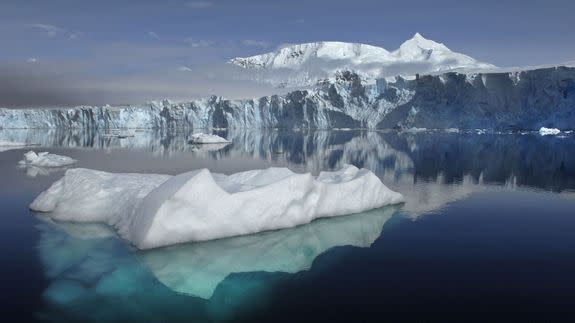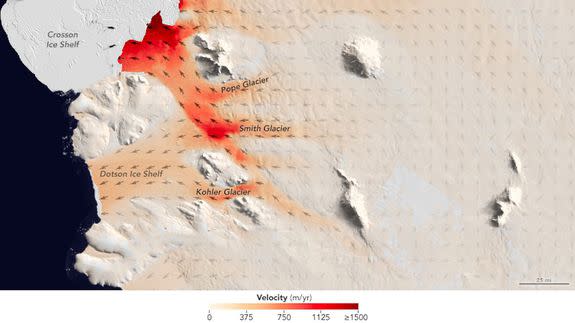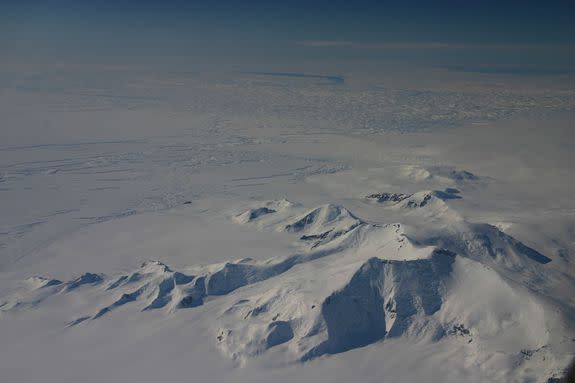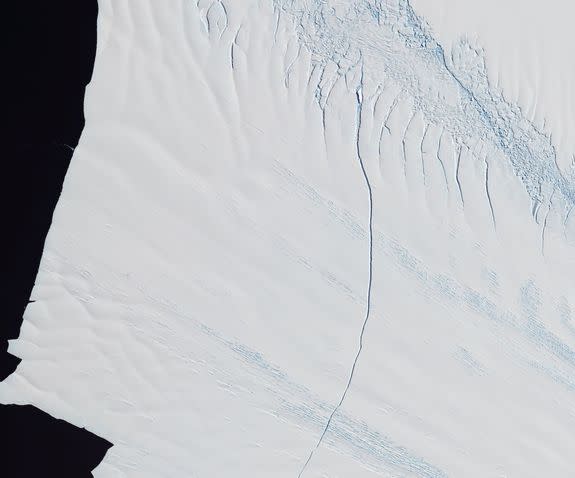Undermined by warm water, Antarctic glacier lost 1,607 feet of ice in under 10 years

A subversive influx of mild, dense salt water is undermining the vast ice shelves of the West Antarctic Ice Sheet, and threatening to destabilize the entire region, thereby raising sea levels worldwide by at least four, and possibly as much as 15 feet.
A new study, published Tuesday in the journal Nature Communications, found that three glaciers that are part of the Dotson and Crosson ice shelves exhibited significant amounts of ice loss and glacier retreat since 2002, with one of the glaciers losing a staggering 1,607 feet of solid ice during the period.
SEE ALSO: The frozen beauty of Antarctica
The role of seawater in Antarctic ice melt may seem counterintuitive at first, since global warming conjures up images of warmer temperatures melting ice from above.

Image: NASA
But scientists have learned that both the air and the sea are conspiring against many ice shelves around the Poles, thinning them from above and below, and causing them to retreat inland, destabilizing the land-based glaciers they help keep in check, like a doorstop.
Some Antarctic glaciers that end in floating ice shelves, such as the Pine Island Glacier in West Antarctica, have retreated to the point where they may already be in the midst of runaway melting that will destabilize larger parts of the ice sheet over the coming decades to centuries.
The sea level rise that could result from such a catastrophic melt would be disastrous for the world’s coastal cities, from New York City to Shanghai.
The new study, by a team of scientists from the California Institute of Technology, University of California at Irvine and NASA’s Jet Propulsion Laboratory, focuses on three glaciers in the Amundsen Sea embayment of West Antarctica: The Smith, Pope and Kohler glaciers.

Image: NASA
These glaciers are located in a region that has the largest net ice mass loss in Antarctica. The study, which relied on airborne radar measurements, found that melting of the ice shelves’ grounding zones (which is where the ice meets the ocean and becomes floating ice) removed between 984 to about 1,607 feet of solid ice beneath the Smith Glacier alone between the years 2000 and 2009.
That translates to an unusually large ice loss rate of about 230 feet per year, which is faster than the melt of the Pine Island Glacier.
Each of the glaciers studied retreated and lost ice mass during the period examined, from 2000 to 2014, though the Smith Glacier had the most ice loss and greatest retreat, and the Kohler Glacier recovered some of its length during the latter half of the period.
Most glacial melting occurs on the underside of the glacier's floating portion, which is known as the ice shelf. As West Antarctic glaciers have become more unstable, their grounding lines have moved inland and deepened, which provides warm ocean waters with easier access to the ice's underbelly and uncorks inland ice to slide into the sea, adding to sea levels.
The researchers found that the Smith Glacier retreated by about 21 miles during the period from 1996 to 2011, which they concluded was partly a result of both the unique topography underneath the ice that allowed more ocean water to sneak in between the ice and the land below.
As the ice melts from below, said the study's lead author, Ala Khazendar, "More sections of the glacier become thinner and float, meaning that the grounding line continues retreating, and so on,” in a press release.

Image: nasa
The study supports other recent research showing that a significant increase in ocean heat helped eat away at the ice shelves of the West Antarctic Ice Sheet during the middle part of the last decade, and that this influx may have temporarily slowed since 2009.
However, there are no signs that a sustained switch to cooler ocean conditions is in the cards, nor is it clear that some glaciers that end in floating ice shelves will stabilize even if the oceans in that area are no longer unusually warm.
A study published earlier this month in the journal Geophysical Research Letters, for example, found that the nearby Pine Island Glacier only slowed its retreat by less than 4 percent despite a nearly 60 percent drop in ocean heat content from 2012 to 2013.
This suggests that once an ice sheet is destabilized, a return to colder conditions may not stop it from continuing to retreat. This is also a concern with the Thwaites Glacier, which acts as a doorstop to a vast expanse of the central Antarctic ice sheet.
SEE ALSO: West Antarctic Glaciers Speeding Toward the Sea, Study Finds
Richard Alley, a researcher at Pennsylvania State University who specializes in glaciers, said the new research adds to the evidence on how glaciers respond to ocean conditions.
“Broadly, it shows that the ice responds rapidly to the ocean, and that sustained cold conditions likely would be required to provide stability,” he said in an email to Mashable.
Alley, who was not involved in the new study, said he is unaware of any indication that such a long-lasting shift to cooler ocean conditions is likely near Antarctica, however.
“I don’t know of any data now indicating that we will have a consistent and sustained cold shift.”
